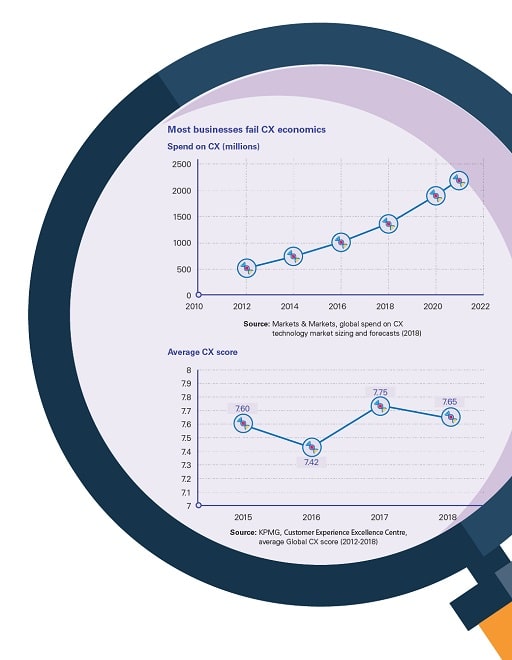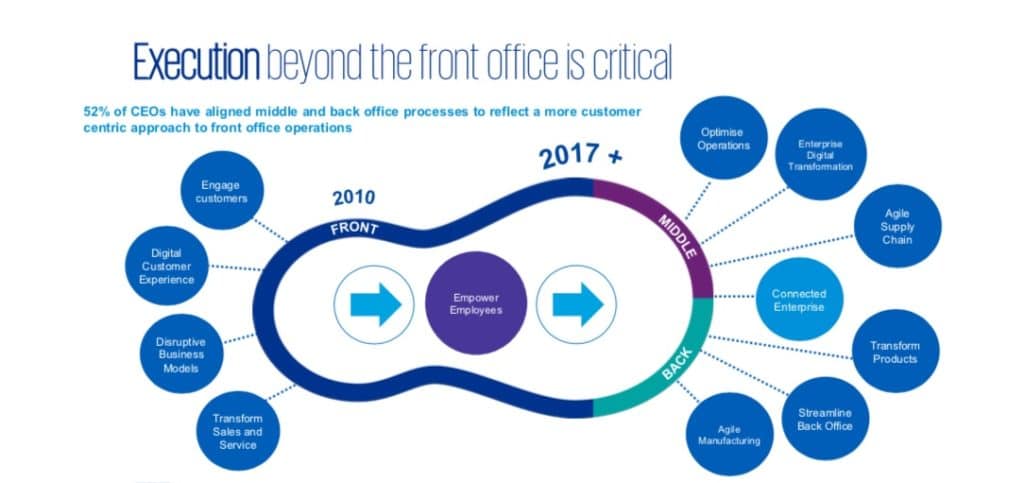Consumers pose one of the key challenges to marketers wanting to produce the best consumer experience. Several new research studies have found consumer expectations of their interactions with brands are outpacing marketers’ abilities to deliver, and customers are driven by two contradictory urges. Consumers want the ease of use of a seamless experience that anticipates their needs, but they are shocked to find out the amount of data they must share with marketers—or are already sharing—to achieve it.
A new study from KPMG found that, despite companies’ rising investments in CX, consumers are still not satisfied. The shortfall is not a failure of focus, but of execution, said Julio Hernandez, national leader, customer advisory at KPMG. He presented the study’s findings at the recent Forrester Customer Experience Forum, where Forrester’s own CX study also found companies working harder just to keep up.
Marketers need to influence the thinking about customer experience in the C-suite and to change the way it’s delivered, “otherwise it’s nice-to-have, like lipstick on a pig,” Hernandez told the conference. Designing outstanding customer experiences and failing to deliver them is “empty calories,” he said.
“The challenge is around execution. People are not executing as well as they could and they are not refining execution by listening to the customer longer-term,” he told Velocitize. “Design is important and CX is important, but I think the execution and delivery is even more.”
Hernandez spoke to Velocitize about the consumer’s “quest for even-better,” the Paradox of Personalization and other findings of the study.

Velocitize: Why this disconnect between insights and execution? Why are consumers’ expectations ahead?
Julio Hernandez: When you think about the 80’s to the 2000’s, technology went from the office home. The PC went from the office to your house. Now, technology goes from the home to the office: “Why can’t I do it my iPhone? Why can’t I use a voice app?”
That’s part of why the consumer experience dictates the business experience, in our day to day working lives and in the b-to-b environment—because we all have been spoiled around what a good experience it was in consumer businesses.
The way most companies are organized, they give the customer to the CMO or the chief customer officer or they give a portion to sales and a portion to marketing and a portion to (customer) service. But they only design the front part.
If you’re Amazon and I want something from you, and it doesn’t show up when it’s supposed to because USPS didn’t deliver it, am I mad at USPS or am I mad at Amazon? I’m mad at Amazon.
You’ve got to get your businesses connected and they have to know how to execute. Part of it is getting the right leadership and aligning the organization behind that leadership and that vision to actually execute it. It’s still very piecemeal.
Does dissatisfaction define the consumer today?
Julio Hernandez: I would say the consumer is in the quest for even better. It’s not to say they’re not satisfied. We don’t settle and the competition and substitutes are all willing to give us something different. That’s what keeps us going.
If I was a CEO, there’s two things I would focus on, in addition to the things I’ve been working on. One is: I would want to make sure that my brand represents something that’s sustainable, tenable; that people want what my brand represents.
It’s a good competitive note, but not “brand” in the way I used to think when I did advertising. It’s the sum of the experiences and what it really represents.
The second thing—and it’s harder to get—is this idea of culture. Do you have an organization that has the customer really at its center? Or are you putting lipstick on the company to say “we’re customer centric?”
I think culture and brand are two ways to continue to excel at customer experience: keeping people tight, making sure you’re aligned to your brand and making sure your people know what you stand for.
Your study also mentioned that some of the best companies are member-owned. Why does CX have to be such a hard sell to shareholders?
Julio Hernandez: Maybe the way to flip it is this some of these public companies and private companies should be thinking of their customers as members and treat them like they’re special and they belong and understand what their value is, as opposed to treating them like a number.
The analogy I use is that if you do CX very well and you do it in a sustainable manner, you move your customer from the income statement to the balance sheet. If they’re on the income statement, they’re a transaction. If they’re on the balance sheet, they’re an asset. They have value and keep giving you returns.
It’s about moving from transactional to relationship. In organizations that are more membership driven they understand that point: that this is where our asset is, this is where our value is, in our customer base.
The study also discusses the “paradox of personalization.” After Edward Snowden’s revelations, there was concern for privacy, but it blew over. With GDPR and Cambridge Analytica, are we seeing another consumer pushback?
Julio Hernandez: There’s absolutely what I call a contract. And the contracts are on personalization and permission.
Companies need to do a better job at at saying: “Can we use your data?” and then be more explicit about how they’re going to use it. GDPR is forcing that, but it also needs to be in a way that the consumer understands it and right now it’s in boilerplate legalese. People don’t understand it.
On the flip side is permission, or the presumption: I presume you’re going to protect my data. I presume that you’re going to use it in the right way. I presume you’re not going to sell it to somebody else. I presume you’re not going to use it for bad purposes. I presume that if something goes wrong, you’re going to let me know. It’s the balance between the permission and the presumption.
The paradox is most people say: “I want you to treat me like you know me.” Well, for me to treat you like I know you, I need to have the data. There is a trust equation that comes in here as well.
If you go back to the Snowden question, I think it blew over because a lot of people like the convenience of personalization. That’s the thing people are going to have to grapple with on a personal basis.
Some people don’t realize how much data is out there on them and how people are using it. We’ve just launched another study into the marketplace; we’re showing people where all the cookies are, so to speak, and all the crumbs to create your data exhaust and how it represents you.
People don’t realize how much is being collected. All the crumbs and all the signals. People know they can talk to Alexa. They don’t know she’s listening 24 hours a day.





Join the conversation